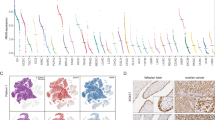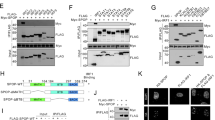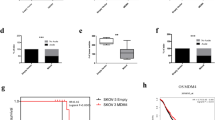Abstract
Serous borderline ovarian tumors (SBOTs) are slow-growing, non-invasive ovarian epithelial neoplasms. SBOTs are considered to be distinct entities that give rise to invasive low-grade serous carcinomas (LGCs), which have a relatively poor prognosis and are unrelated to high-grade serous carcinomas (HGCs). The mechanisms underlying the progression of non-invasive SBOTs to invasive epithelial ovarian carcinomas are not understood. We recently established short-term cultures of SBOT cells from tumor biopsies and showed that inactivation of p53, retinoblastoma (Rb) and/or PP2A by the simian virus 40 (SV40) large (LT) and small T antigens extends the life span of the cells and endows them with the ability to invade Matrigel-coated transwells. In this study, we show that concurrent inhibition of p53 and Rb by the SV40 LT produces cells (referred to as SBOT4-LT) with increased life span and cell invasion. To distinguish the roles of p53 and Rb in the progression from SBOTs to invasive ovarian carcinomas, we performed small interfering RNA-mediated knockdown of endogenous p53 in a spontaneously immortalized SBOT cell line, SBOT3.1, which increased cell invasion. This increased invasive activity was associated with the transcriptional downregulation of E-cadherin, correlated with an increase in PIK3CA levels and the increased activation of Akt. Conversely, in invasive LGC-derived MPSC1 cells, enhancing the levels of p53 decreased cell invasion and diminished the phosphatidylinositol 3-kinase (PI3K)/Akt-mediated downregulation of E-cadherin. Inhibition of Rb also enhanced invasiveness, but did not affect the levels of PIK3CA and E-cadherin in SBOT3.1 cells, suggesting that it functions by a different pathway. To our knowledge, this study is the first to show that p53 has an important role in the progression from SBOTs to invasive carcinomas. In addition, our findings suggest that downregulation of E-cadherin by the PI3K/Akt pathway contributes to this progression.
This is a preview of subscription content, access via your institution
Access options
Subscribe to this journal
Receive 50 print issues and online access
$259.00 per year
only $5.18 per issue
Buy this article
- Purchase on Springer Link
- Instant access to full article PDF
Prices may be subject to local taxes which are calculated during checkout






Similar content being viewed by others
References
Arima Y, Inoue Y, Shibata T, Hayashi H, Nagano O, Saya H et al. (2008). Rb depletion results in deregulation of E-cadherin and induction of cellular phenotypic changes that are characteristic of the epithelial-to-mesenchymal transition. Cancer Res 68: 5104–5112.
Astanehe A, Arenillas D, Wasserman WW, Leung PC, Dunn SE, Davies BR et al. (2008). Mechanisms underlying p53 regulation of PIK3CA transcription in ovarian surface epithelium and in ovarian cancer. J Cell Sci 121: 664–674.
Birchmeier W, Behrens J . (1994). Cadherin expression in carcinomas: role in the formation of cell junctions and the prevention of invasiveness. Biochim Biophys Acta 1198: 11–26.
Bolos V, Peinado H, Perez-Moreno MA, Fraga MF, Esteller M, Cano A . (2003). The transcription factor Slug represses E-cadherin expression and induces epithelial to mesenchymal transitions: a comparison with Snail and E47 repressors. J Cell Sci 116: 499–511.
Bonome T, Lee JY, Park DC, Radonovich M, Pise-Masison C, Brady J et al. (2005). Expression profiling of serous low malignant potential, low-grade, and high-grade tumors of the ovary. Cancer Res 65: 10602–10612.
Campbell IG, Russell SE, Choong DY, Montgomery KG, Ciavarella ML, Hooi CS et al. (2004). Mutation of the PIK3CA gene in ovarian and breast cancer. Cancer Res 64: 7678–7681.
Cano A, Perez-Moreno MA, Rodrigo I, Locascio A, Blanco MJ, del Barrio MG et al. (2000). The transcription factor snail controls epithelial-mesenchymal transitions by repressing E-cadherin expression. Nat Cell Biol 2: 76–83.
Darai E, Scoazec JY, Walker-Combrouze F, Mlika-Cabanne N, Feldmann G, Madelenat P et al. (1997). Expression of cadherins in benign, borderline, and malignant ovarian epithelial tumors: a clinicopathologic study of 60 cases. Hum Pathol 28: 922–928.
Derksen PW, Liu X, Saridin F, van der Gulden H, Zevenhoven J, Evers B et al. (2006). Somatic inactivation of E-cadherin and p53 in mice leads to metastatic lobular mammary carcinoma through induction of anoikis resistance and angiogenesis. Cancer Cell 10: 437–449.
Fresno Vara JA, Casado E, de Castro J, Cejas P, Belda-Iniesta C, Gonzalez-Baron M . (2004). PI3K/Akt signalling pathway and cancer. Cancer Treat Rev 30: 193–204.
Gershenson DM, Silva EG, Tortolero-Luna G, Levenback C, Morris M, Tornos C . (1998). Serous borderline tumors of the ovary with noninvasive peritoneal implants. Cancer 83: 2157–2163.
Grille SJ, Bellacosa A, Upson J, Klein-Szanto AJ, van Roy F, Lee-Kwon W et al. (2003). The protein kinase Akt induces epithelial mesenchymal transition and promotes enhanced motility and invasiveness of squamous cell carcinoma lines. Cancer Res 63: 2172–2178.
Hahn WC, Dessain SK, Brooks MW, King JE, Elenbaas B, Sabatini DM et al. (2002). Enumeration of the simian virus 40 early region elements necessary for human cell transformation. Mol Cell Biol 22: 2111–2123.
Ho CL, Kurman RJ, Dehari R, Wang TL, Shih Ie M . (2004). Mutations of BRAF and KRAS precede the development of ovarian serous borderline tumors. Cancer Res 64: 6915–6918.
Huber MA, Kraut N, Beug H . (2005). Molecular requirements for epithelial-mesenchymal transition during tumor progression. Curr Opin Cell Biol 17: 548–558.
Larue L, Bellacosa A . (2005). Epithelial-mesenchymal transition in development and cancer: role of phosphatidylinositol 3′ kinase/AKT pathways. Oncogene 24: 7443–7454.
Lee JM, Dedhar S, Kalluri R, Thompson EW . (2006). The epithelial-mesenchymal transition: new insights in signaling, development, and disease. J Cell Biol 172: 973–981.
Parker RL, Clement PB, Chercover DJ, Sornarajah T, Gilks CB . (2004). Early recurrence of ovarian serous borderline tumor as high-grade carcinoma: a report of two cases. Int J Gynecol Pathol 23: 265–272.
Pohl G, Ho CL, Kurman RJ, Bristow R, Wang TL, Shih Ie M . (2005). Inactivation of the mitogen-activated protein kinase pathway as a potential target-based therapy in ovarian serous tumors with KRAS or BRAF mutations. Cancer Res 65: 1994–2000.
Roger L, Jullien L, Gire V, Roux P . (2010). Gain of oncogenic function of p53 mutants regulates E-cadherin expression uncoupled from cell invasion in colon cancer cells. J Cell Sci 123: 1295–1305.
Roymans D, Slegers H . (2001). Phosphatidylinositol 3-kinases in tumor progression. Eur J Biochem 268: 487–498.
Samuels Y, Wang Z, Bardelli A, Silliman N, Ptak J, Szabo S et al. (2004). High frequency of mutations of the PIK3CA gene in human cancers. Science 304: 554.
Schuijer M, Berns EM . (2003). TP53 and ovarian cancer. Hum Mutat 21: 285–291.
Shayesteh L, Lu Y, Kuo WL, Baldocchi R, Godfrey T, Collins C et al. (1999). PIK3CA is implicated as an oncogene in ovarian cancer. Nat Genet 21: 99–102.
Shih Ie M, Kurman RJ . (2005). Molecular pathogenesis of ovarian borderline tumors: new insights and old challenges. Clin Cancer Res 11: 7273–7279.
Singer G, Stohr R, Cope L, Dehari R, Hartmann A, Cao DF et al. (2005). Patterns of p53 mutations separate ovarian serous borderline tumors and low- and high-grade carcinomas and provide support for a new model of ovarian carcinogenesis: a mutational analysis with immunohistochemical correlation. Am J Surg Pathol 29: 218–224.
Sun M, Wang G, Paciga JE, Feldman RI, Yuan ZQ, Ma XL et al. (2001). AKT1/PKBalpha kinase is frequently elevated in human cancers and its constitutive activation is required for oncogenic transformation in NIH3T3 cells. Am J Pathol 159: 431–437.
Veatch AL, Carson LF, Ramakrishnan S . (1994). Differential expression of the cell-cell adhesion molecule E-cadherin in ascites and solid human ovarian tumor cells. Int J Cancer 58: 393–399.
Vleminckx K, Vakaet Jr L, Mareel M, Fiers W, van Roy F . (1991). Genetic manipulation of E-cadherin expression by epithelial tumor cells reveals an invasion suppressor role. Cell 66: 107–119.
Wang SP, Wang WL, Chang YL, Wu CT, Chao YC, Kao SH et al. (2009). p53 controls cancer cell invasion by inducing the MDM2-mediated degradation of Slug. Nat Cell Biol 11: 694–704.
Woo MM, Salamanca CM, Minor A, Auersperg N . (2007). An improved assay to quantitate the invasiveness of cells in modified Boyden chambers. In vitro Cell Dev Biol Anim 43: 7–9.
Woo MM, Salamanca CM, Symowicz J, Stack MS, Miller DM, Leung PC et al. (2008). SV40 early genes induce neoplastic properties in serous borderline ovarian tumor cells. Gynecol Oncol 111: 125–131.
Woo MM, Salamanca CM, Miller M, Symowicz J, Leung PC, Oliveira C et al. (2008). Serous borderline ovarian tumors in long-term culture: phenotypic and genotypic distinction from invasive ovarian carcinomas. Int J Gynecol Cancer 18: 1234–1247.
Yang J, Mani SA, Donaher JL, Ramaswamy S, Itzykson RA, Come C et al. (2004). Twist, a master regulator of morphogenesis, plays an essential role in tumor metastasis. Cell 117: 927–939.
Zhao R, Gish K, Murphy M, Yin Y, Notterman D, Hoffman WH et al. (2000). Analysis of p53-regulated gene expression patterns using oligonucleotide arrays. Genes Dev 14: 981–993.
Acknowledgements
This work was supported by grants from the National Cancer Institute of Canada, with funds from the Canadian Cancer Society to NA and Canadian Institutes of Health Research to PCKL. We thank Dr David Huntsman and Winnie Yang (Centre for Translational and Applied Genomics, BC Cancer Agency) for providing the sequence data. We thank Dr Ie-Ming Shih (Department of Pathology, Johns Hopkins Medical Institutions) for providing the MPSC1 cells. We greatly appreciate the advice and help of Drs Christian Klausen and Michelle Woo.
Author information
Authors and Affiliations
Corresponding author
Ethics declarations
Competing interests
The authors declare no conflict of interest.
Additional information
Supplementary Information accompanies the paper on the Oncogene website
Supplementary information
Rights and permissions
About this article
Cite this article
Cheng, JC., Auersperg, N. & Leung, P. Inhibition of p53 induces invasion of serous borderline ovarian tumor cells by accentuating PI3K/Akt-mediated suppression of E-cadherin. Oncogene 30, 1020–1031 (2011). https://doi.org/10.1038/onc.2010.486
Received:
Revised:
Accepted:
Published:
Issue Date:
DOI: https://doi.org/10.1038/onc.2010.486
Keywords
This article is cited by
-
Plasticity in Ovarian Cancer: The Molecular Underpinnings and Phenotypic Heterogeneity
Journal of the Indian Institute of Science (2020)
-
TSH overcomes BrafV600E-induced senescence to promote tumor progression via downregulation of p53 expression in papillary thyroid cancer
Oncogene (2016)
-
CD40 ligand induces RIP1-dependent, necroptosis-like cell death in low-grade serous but not serous borderline ovarian tumor cells
Cell Death & Disease (2015)
-
A miR-199a/miR-214 Self-Regulatory Network via PSMD10, TP53 and DNMT1 in Testicular Germ Cell Tumor
Scientific Reports (2014)
-
Distinct genetic alterations occur in ovarian tumor cells selected for combined resistance to carboplatin and docetaxel
Journal of Ovarian Research (2012)



